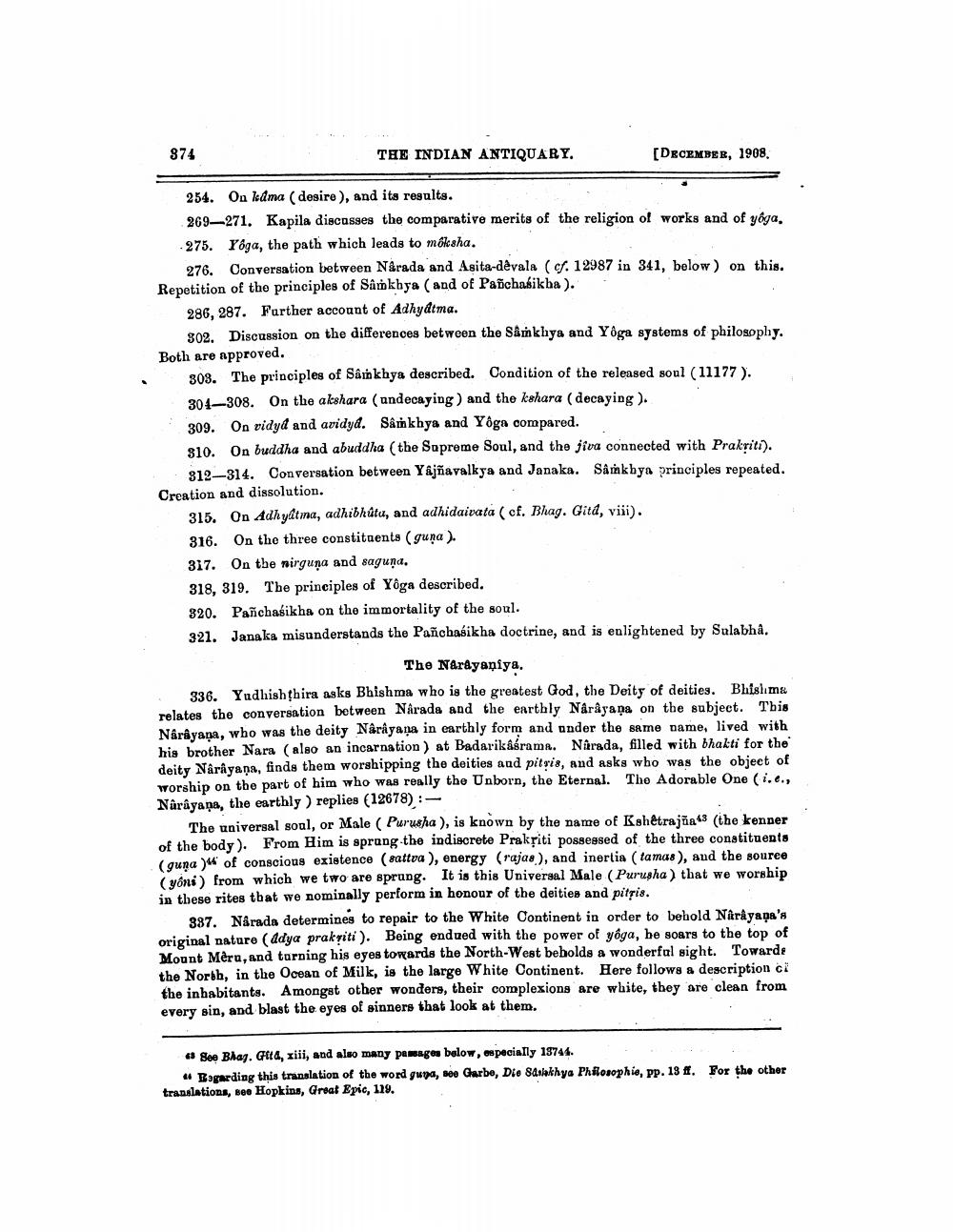________________
874
THE INDIAN ANTIQUARY.
[DECEMBER, 1908.
254. On kama (desire), and its results.
269-271. Kapila discusses the comparative merits of the religion of works and of yoga. 275. Yoga, the path which leads to moksha.
276. Conversation between Narada and Asita-dêvala (cf. 12987 in 341, below) on this. Repetition of the principles of Sâmkhya (and of Pañchaśikha).
286, 287. Further account of Adhyatma.
302. Discussion on the differences between the Sâmkhya and Yoga systems of philosophy. Both are approved.
303. The principles of Sâinkhya described. Condition of the released soul (11177).
304-308. On the akshara (undecaying) and the kshara (decaying).
309. On vidyd and avidyd. Sâm khya and Yoga compared.
310. On buddha and abuddha (the Supreme Soul, and the jiva connected with Prakriti). 312-314. Conversation between Yajnavalkya and Janaka. Sâmkhya principles repeated. Creation and dissolution.
315. On Adhyatma, adhibhûta, and adhidaivata (cf. Bhag. Gitd, viii).
316. On the three constituents (guna).
317. On the nirguna and saguna.
318, 319. The principles of Yoga described.
320. Pañchasikha on the immortality of the soul.
321. Janaka misunderstands the Pañchaśikha doctrine, and is enlightened by Sulabha.
The Narayaniya.
336. Yudhishthira asks Bhishma who is the greatest God, the Deity of deities. Bhishma relates the conversation between Nârada and the earthly Nârâyana on the subject. This Narayana, who was the deity Narayana in earthly form and under the same name, lived with his brother Nara (also an incarnation) at Badarikáérama. Narada, filled with bhakti for the deity Nârâyana, finds them worshipping the deities and pityis, and asks who was the object of worship on the part of him who was really the Unborn, the Eternal. The Adorable One (i.e., Narayana, the earthly) replies (12678):
The universal soul, or Male ( Purusha), is known by the name of Kshetrajñas (the kenner of the body). From Him is sprung the indiscrete Prakriti possessed of the three constituents (guna) of conscious existence (sattva), energy (rajas), and inertia (tamas), and the source (yoni) from which we two are sprung. It is this Universal Male (Purusha) that we worship in these rites that we nominally perform in honour of the deities and pitṛis.
337. Narada determines to repair to the White Continent in order to behold Narayana's original nature (adya prakṛiti). Being endued with the power of yoga, he soars to the top of Mount Meru, and turning his eyes towards the North-West beholds a wonderful sight. Towards the North, in the Ocean of Milk, is the large White Continent. Here follows a description ci the inhabitants. Amongst other wonders, their complexions are white, they are clean from every sin, and blast the eyes of sinners that look at them.
43 See Bhag. Gita, xiii, and also many passages below, especially 18744.
44 Begarding this translation of the word guya, see Garbe, Die Sasakhya Philosophie, pp. 13 ff. For the other translations, see Hopkins, Great Epic, 119.




